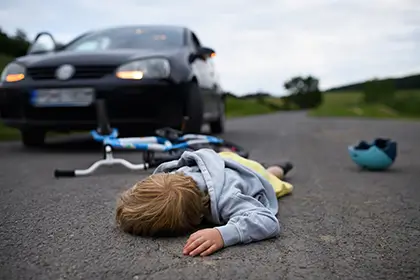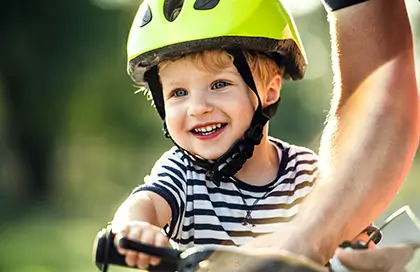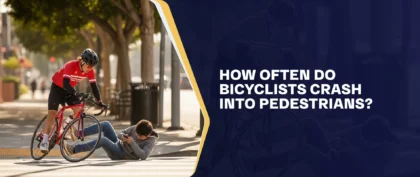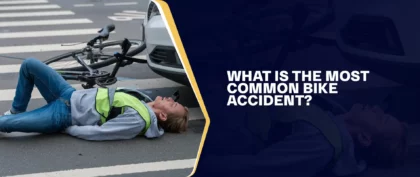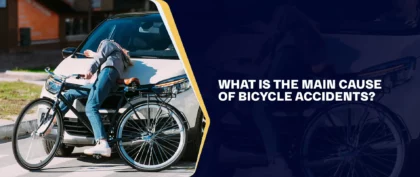Table of Contents

In an ideal world where kids are carefree and playful, a harsh reality often taints their innocence. It’s alarming that hundreds of children are injured in bike accidents every day, causing distress for them and their parents. The fear the parents feel and the pain the child endures are something we truly empathize with. Understanding the emotional and physical challenges you and your child grapple with, we are here for you every step of the way.
Riding a bike should be a source of joy and liberation, not a cause of pain and anxiety. If your child was injured in a bike accident, the bicycle accident lawyers at Arash Law are here to guide you through the legal process. We understand your situation and the importance of seeking a fair resolution for your case. Contact us at (888) 488-1391 for a free initial consultation.
Our attorneys closely examine bike accidents affecting children, helping you understand why they happen and how to prevent them. In doing so, we advocate for safer roads for young cyclists in the future.
Child Bicycle Accidents By The Numbers
Child bicycle accidents are a matter of significant concern, and the statistics paint a picture of the risks young riders face:
- Frequency — In the United States alone, thousands of children are involved in bicycle accidents yearly. According to the Centers for Disease Control and Prevention (CDC), over 400,000 kids between the ages of 0 and 19 receive emergency room treatment each year for bicycle-related injuries.
- Age Group Vulnerability — The risk of bicycle-related injuries is highest in children between 5 and 14. They accounted for the most frequent emergency department visits for such injuries.
- Head Injuries — Head injuries are among the most common and severe consequences of bicycle accidents involving children. The startling statistic is that nearly 60% of bicycle-related injuries to children involve head injuries. This highlights the crucial importance of wearing helmets while riding.
- Fatalities — While most child bicycle accidents result in non-fatal injuries, tragically, some end in fatalities. In the United States, an average of 100 children die in bicycle-related accidents annually.
- Factors Contributing to Accidents — Various factors contribute to these accidents, including collisions with motor vehicles, riding without protective gear, a lack of proper supervision, and even inadequate road infrastructure.
- Gender Differences — Data also reveal gender disparities in bicycle accidents. Boys are more likely to be involved in such accidents and sustain injuries than girls.
- Safety Measures — Encouragingly, helmets have been shown to reduce the risk of head injuries significantly. However, a concerning report is that many children still do not consistently wear helmets while cycling.
- Educational Initiatives — Programs promoting bicycle safety education and helmet use have shown promise in reducing the incidence of child bicycle accidents.
These figures are an alarming reminder of how important it is to take child cycling safety seriously. While biking is a healthy and enjoyable activity, understanding the risks and implementing safety measures is paramount to help our young riders safely explore the world on two wheels.
Common Injuries Sustained By Kids In Bike Accidents
There are several types of injuries that children sustain as a result of bike accidents, including:
- Head Injuries — In bicycle accidents, head injuries are the most serious and common type. Traumatic brain injuries (TBIs) can range in severity from minor concussions to severe brain damage. A correctly fitted helmet reduces the risk of head injuries significantly.
- Fractures — Broken bones, such as wrist, arm, and collarbone fractures, are frequently seen in bike accidents. Kids often use their arms to break a fall, which can lead to fractures in the upper extremities.
- Abrasions and Road Rash — Scrapes and abrasions, commonly known as “road rash,” occur when the skin makes contact with the pavement upon impact. These injuries can vary in severity but are typically painful and may require cleaning and bandaging.
- Contusions and Bruises — Bruises are common and can occur where the body has made direct contact with the ground, objects, or other vehicles during the accident.
- Facial Injuries — Facial injuries, such as cuts, bruises, and dental injuries, can result if a child’s face comes into contact with the handlebars, the ground, or other objects during a fall.
- Sprains and Strains — The impact force during a bike accident can cause soft tissue injuries, such as sprains and strains in the wrists, ankles, or knees.
- Lacerations — Deep cuts and lacerations can occur if a child collides with sharp objects or falls on a debris-laden surface. These injuries may require stitches or surgical intervention.
- Internal Injuries — In more severe accidents involving high-speed collisions or impacts with motor vehicles, internal injuries like abdominal trauma or organ damage can occur.
- Emotional Trauma — Beyond physical injuries, children can also experience emotional trauma following a bike accident. The incident-related worry and anxiety may have a long-lasting effect on their mental health.
- Spinal Injuries — While less common than other injuries, spinal injuries can occur in severe accidents. These wounds need quick medical attention since they can have long-term effects.
Preventing these injuries involves promoting safe cycling practices, ensuring children wear protective gear such as helmets, teaching them how to navigate traffic safely, and making sure bikes are in good working condition. In addition, proper guidance and bike safety instruction can greatly lower the likelihood of accidents and injuries in young riders.
Underlying Causes Of Bike Accidents And Injuries
Bike accidents and injuries often stem from a combination of factors. These include the failure to wear helmets, inadequate supervision of children, and riding without essential safety gear like reflectors or lights, especially in low-light conditions. Disregarding traffic laws, engaging in distractions like phone use, and riding under the influence of alcohol or drugs can further heighten the risk of accidents.
Additionally, unsafe riding practices such as going against traffic, riding recklessly, poorly maintained bicycles, and even adverse weather conditions can contribute to incidents. Another factor is the driver’s carelessness, like neglecting to yield to cyclists or opening car doors before looking for approaching bicyclists. It’s critical to address these underlying issues and promote bike safety through improved infrastructure, education, and responsible driving and riding by both drivers and cyclists.
Bike Helmets, Bike Accidents, And Traumatic Brain Injuries
Wearing a helmet can significantly reduce the risk of traumatic brain injuries (TBIs) in bicycle accidents. TBIs can have long-lasting and devastating consequences, making helmet use a vital safety measure for cyclists of all ages. When a cyclist is involved in an accident, their head is particularly vulnerable to impact, and without proper protection, a fall or collision can result in a TBI.
Helmets are made to absorb and distribute impact energy, lowering the risk of severe head injuries. Research consistently shows that wearing a properly fitted helmet can significantly reduce the risk of TBIs and other head injuries in bike accidents. Therefore, it’s not only advisable but also often legally required in many jurisdictions to wear a helmet while cycling. Promoting helmet use and ensuring it meets safety standards are essential in safeguarding cyclists’ well-being and preventing the devastating consequences of TBIs in bike accidents.
According to the National Library of Medicine, wearing a helmet reduces the risk of head and brain injuries by 65% to 88% and lower and middle face injuries by 65%. Helmets offer protection in all types of collisions, whether or not a motor vehicle is present, and are helpful for cyclists of all ages.
Important Ways Of Reducing The Risk Of Bicycle Crashes
Reducing the risk of cycling crashes and injuries among kids is paramount. Here are specific measures to help decrease the possibility of cycling crashes in children:
- Always Wear Helmets — Encourage children to always wear helmets that are correctly fitted when cycling. Helmets substantially reduce the possibility of head injuries during falls or other incidents.
- Supervision — Adults or responsible caregivers should closely monitor young children while cycling. This supervision helps kids learn safe riding habits and navigate traffic or hazards.
- Teach Safe Riding Skills — Educate children about safe riding practices, including obeying traffic rules, signaling turns, and looking for oncoming vehicles. Teach children to always double-check before crossing junctions.
- Age-Appropriate Bikes — Ensure children ride bikes that are the right size for their age and height. Ill-fitting bikes can be challenging to control and may lead to accidents.
- Regular Bike Maintenance — Periodically inspect and maintain children’s bicycles to keep them in good working order. Check brakes, tires, and other components to prevent mechanical failures that could lead to accidents.
- Visibility — Encourage using bright clothing and reflective accessories to enhance visibility, especially during low-light or nighttime conditions.
- Safe Routes — Identify safe routes for children to ride on, such as designated bike paths, quiet residential streets, or parks. Avoid routes with heavy traffic or dangerous intersections whenever possible.
- Traffic Education — Teach children about traffic signals and the importance of stopping at stop signs and yielding the right of way. Encourage them to be aware of their surroundings at all times.
- Crosswalk Safety — Teach children how to use crosswalks safely. Emphasize the importance of dismounting and walking their bikes when crossing busy streets.
- Avoid Distractions — Instruct children to avoid distractions like using smartphones or listening to music while riding. These distractions can divert their attention from the road.
- Practice Falling Safely — Teach children how to fall safely, which includes rolling with the fall to minimize the impact on their head and body.
- Regular Safety Checks — Always review safety rules with children and reinforce good riding habits. Make safety discussions a routine part of their biking experience.
- Lead by Example — Be a role model by wearing a helmet, following traffic rules, and practicing safe cycling habits when riding with children.
- Advocate for Safe Infrastructure — Encourage the development of safer road infrastructure, including bike lanes, crosswalks, and well-maintained road surfaces.
- Stay Informed — Follow any updates on traffic laws, safety recommendations, and recent information on child bicycling safety.
By implementing these measures and fostering a culture of bicycle safety from an early age, we can significantly reduce the risk of cycling crashes and injuries among children while allowing them to enjoy its benefits.
Why Should Kids Wear A Bike Helmet?
Whether your child is skating or riding a bike, scooter, or skateboard, helmets provide a layer of safety against head and brain injuries. However, a helmet only offers protection when it is properly fitted. Instill the habit of wearing a helmet in your child from a young age.
Children should wear bike helmets primarily to prevent head injuries, which can be severe and even life-threatening. Helmets are designed to absorb the force of impact during a fall or collision, thus protecting the brain and reducing the risk of traumatic injuries. Beyond physical safety, helmet use is often a legal requirement, instilling a sense of responsibility and compliance with safety laws from a young age.
It also encourages responsible behavior among peers, as children tend to emulate what they see. Helmets also protect kids from unexpected accidents and promote outdoor play and exploration while providing peace of mind to parents. Ultimately, wearing a helmet is vital in fostering a safety culture, protecting cognitive development, and promoting long-term well-being in children who love to cycle.
What Is The Right Bike For Me?
When buying a bike, it’s essential to consider the following factors to determine what is right for you:
- Desired Use — Selecting the right bike begins with clearly understanding your intended use. Whether for commuting, leisurely rides, mountain biking, or road cycling, each bike type is designed to excel in specific situations.
- Budget — Check your budget to see if your desired bike is within your reach. Moreover, consider accessories such as helmets and locks when determining your budget.
- Fit and Comfort — Bikes come in different sizes and shapes. Ensure that the frame size matches your height and riding comfort. Consider your preferred riding position, be it upright or more aerodynamic. Gearing, brakes, wheel size, and suspension also play roles in the overall riding experience, so tailor your choice to your terrain and fitness level. What looks good in an advertisement or on the showroom floor might not fit your body type. Taking a test ride lets you check that you’re comfortable and that the bike suits your height, reach, and riding style.
- Performance — Each bike will perform differently based on its design, weight, tire type, and other factors. Testing a bike allows you to understand its performance characteristics, such as acceleration, braking, and handling, and see whether they meet your expectations.
- Personal Connection — Riders sometimes choose bikes based on the unquantifiable feeling they get from riding them. You might be drawn to one bike for reasons you cannot explain. Test drives can help you discover that special connection.
- Maintenance Costs — When choosing a bicycle, considering maintenance costs is essential. A durable bike means fewer repairs, saving both money and stress down the road. It’s all about smart, long-term choices. Finally, don’t forget to consider any necessary accessories and maintenance when choosing the perfect bike that aligns with your needs and preferences.
What Should I Wear When I Ride My Bike?
Weather and personal comfort should influence your clothing choice when preparing for a bike ride. Helmets are a non-negotiable safety item, as they offer crucial head protection.
For attire, opt for breathable and moisture-wicking fabrics in hot weather. On the other hand, layering is essential for maintaining warmth in cold conditions. Padded cycling shorts can enhance comfort on long rides, and closed-toe shoes with good grip are ideal for pedaling. Gloves provide grip and protection, while eye protection, like sunglasses, shields your eyes from the elements.
In low-light situations, enhance visibility with reflective clothing or accessories. Waterproof gear keeps you dry in wet conditions, and sunscreen protects your skin from UV rays. Ultimately, your clothing should prioritize comfort and safety while aligning with your cycling needs and weather conditions.
Where Is It Safe To Ride My Bike?
According to the National Highway Traffic Safety Administration, riding a bicycle on the street, where cyclists are required to adhere to the same traffic laws as cars and travel in the same direction, is the safest option.
However, you can safely ride your bike in places like dedicated bike lanes, parks with bike paths, cycling trails, and quiet residential streets with less traffic. School campuses often have bike-friendly areas, and some cities are known for being bike-friendly, with extensive bike lanes. Recreational facilities and organized group rides can provide secure riding experiences. Coastal areas often have bike paths along beaches and boardwalks. In rural areas, choose quieter country roads for cycling, but be cautious of road conditions. Regardless of where you ride, always follow traffic rules, wear a helmet, and stay alert for safety.
What Road Rules Should I Know?
Knowing and following the rules of the road is essential for safe and responsible cycling, especially when you are permitted to ride a bicycle on a public road. Here are some key road rules that cyclists should be aware of:
- Obey Traffic Signals — Cyclists must obey traffic signals and signs like motorists. Keep right of way when appropriate, and stop at stop signs and red lights.
- Use Hand Signals — Signal your intentions using hand signals when turning or changing lanes. Extend your left arm straight out to indicate a left turn, bend your left arm at a right angle upward to indicate a right turn, and bend your left arm downward to indicate a stop or slow down.
- Ride in the Same Direction As Traffic — Always travel in the same direction as oncoming traffic. Riding opposite the flow of traffic increases the risk of accidents.
- Stay to the Right — When riding on the road, keep as far to the right as practical. Use the right-hand lane when available and safe.
- Pass on the Left — When overtaking another vehicle or cyclist, pass on the left side. Announce your presence with a verbal warning or bell when passing pedestrians.
- Utilize Designated Bike Lanes and Paths — Utilize designated bike lanes and paths whenever practical. In the absence of bike lanes, stick to the right side of the road.
- Yield to Pedestrians — Drivers should always give way to pedestrians in crosswalks and on sidewalks. When passing, slow down and give enough time.
- Avoid Riding on Sidewalks — In some areas, riding on sidewalks is prohibited. Check local regulations to determine if sidewalk cycling is allowed.
- Lights and Reflectors — Use lights and reflectors on your bike, especially when riding in low-light conditions or at night. A white front light and red rear light or reflector are typically required.
- Stop for School Buses — When bicyclists come along a stopped school bus with its lights flashing and the stop sign extended, they must slow down and wait until the bus moves forward or retracts its stop sign.
- Stay Alert — Be aware of your surroundings and take precautions if there are any threats. Avoid using your phone or listening to music while you are driving.
- Wear a Helmet — In many places, cyclists, especially children, are required to wear helmets. Even where it’s not legally required, it’s strongly recommended for safety.
- Alcohol and Drugs — Drinking or using drugs while biking impairs judgment and coordination, increasing the likelihood of an accident. Avoid cycling when intoxicated.
- Respect Traffic Flow — Be courteous to motorists and other road users. Follow the traffic flow and avoid aggressive or erratic behavior.
- Maintenance — Keep your bike in good working order. Faulty brakes, tires, or other components can compromise safety.
Understanding and adhering to these rules is essential for safe cycling and ensuring harmonious coexistence with other road users. Familiarize yourself with local cycling laws and regulations, as they can vary from one area to another.
How Do I Signal My Turns?
Signaling your turns is essential for communicating your intentions to other road users, whether cycling in traffic or on a bike path. Here’s how to signal your turns while cycling:
- Left Turn:
- Extend your left arm straight out to the side.
- Point your left arm horizontally in the direction of the turn.
- Maintain this signal until you’ve safely completed the left turn.
- Right Turn:
- Extend your left arm out to the side.
- Bend your left arm at a right angle upward, creating an “L” shape.
- Point your left hand and arm in the direction of the turn.
- Keep your arm in this position until you’ve completed the right turn.
- Stopping or Slowing Down:
- Extend your left arm out to the side.
- Bend your left arm at a right angle downward, creating an “L” shape that points to the ground.
- This signal indicates that you are slowing down or coming to a stop.
Remember to make these signals clearly and before your turn or stop to give other road users sufficient time to react. Additionally, if you have a bell or horn on your bike, using it as an audible signal can provide extra warning to those around you. Signaling your turns and intentions helps enhance overall road safety for you and other road users.
Seeking Legal Support And Guidance With Arash Law: Helping Your Child After A Bike Accident
At Arash Law, under the direction of Arash Khorsandi, Esq., we understand the emotional and financial toll a bike accident involving your child can take on your family. Our personal injury lawyers provide legal support and guidance to help you through this challenging time. Your child’s safety and well-being are of the utmost importance, and we are committed to seeking compensation on their behalf.
If your child was involved in a bike accident, don’t hesitate to contact Arash Law. Our California bicycle accident lawyers can explain your possible legal remedies and help you pursue damages for your child’s injuries. Call us at (888) 488-1391 or complete our form to arrange a free initial consultation.

